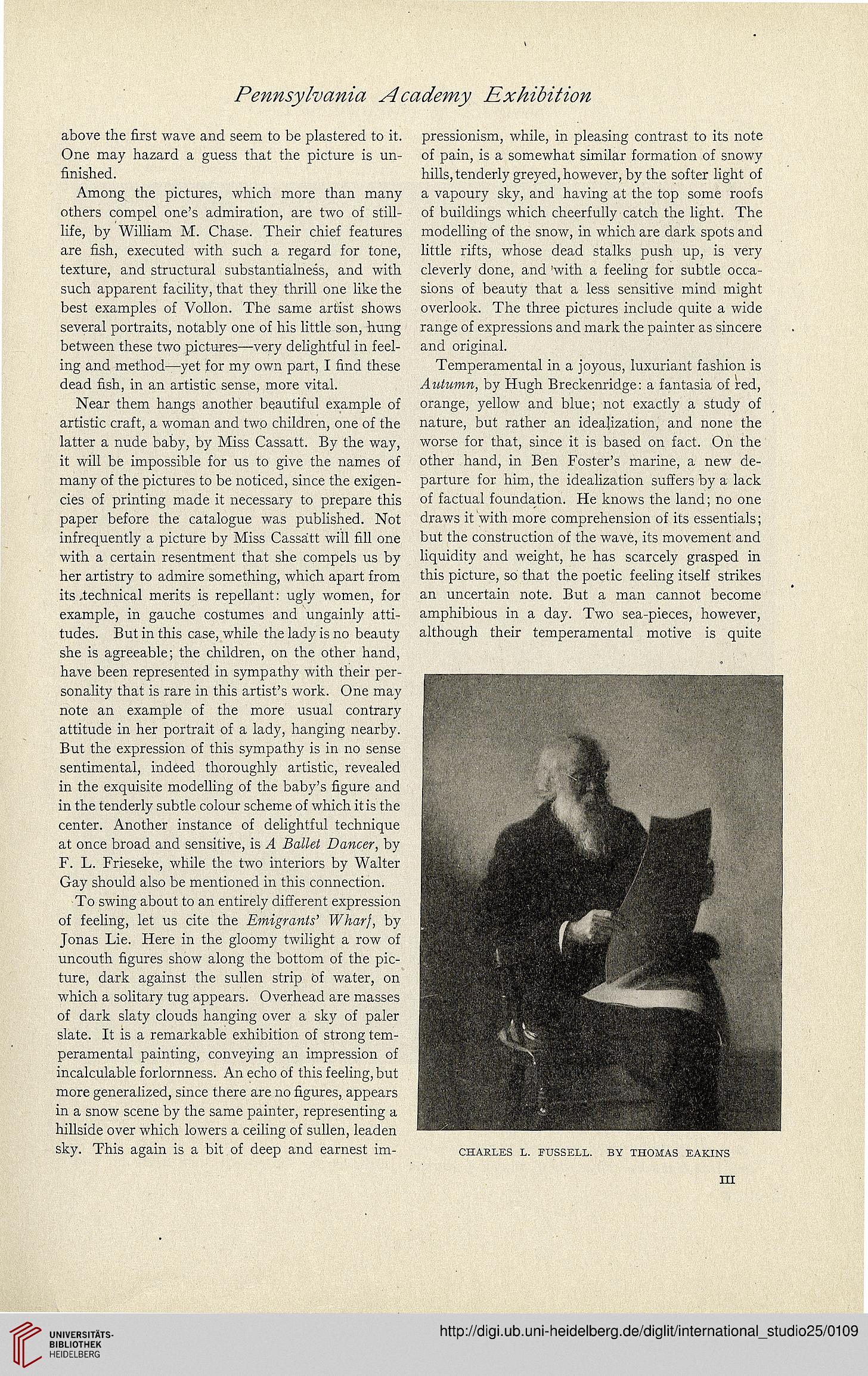above the first wave and seem to be plastered to it.
One may hazard a guess that the picture is un-
finished.
Among the pictures, which more than many
others compel one's admiration, are two of still-
life, by William M. Chase. Their chief features
are fish, executed with such a regard for tone,
texture, and structural substantialness, and with
such apparent facility, that they thrill one like the
best examples of Vollon. The same artist shows
several portraits, notably one of his little son, hung
between these two pictures—very delightful in feel-
ing and method—yet for my own part, I find these
dead fish, in an artistic sense, more vital.
Near them hangs another beautiful example of
artistic craft, a woman and two children, one of the
latter a nude baby, by Miss Cassatt. By the way,
it will be impossible for us to give the names of
many of the pictures to be noticed, since the exigen-
cies of printing made it necessary to prepare this
paper before the catalogue was published. Not
infrequently a picture by Miss Cassatt will fill one
with a certain resentment that she compels us by
her artistry to admire something, which apart from
its .technical merits is repellant: ugly women, for
example, in gauche costumes and ungainly atti-
tudes. But in this case, while the lady is no beauty
she is agreeable; the children, on the other hand,
have been represented in sympathy with their per-
sonality that is rare in this artist's work. One may
note an example of the more usual contrary
attitude in her portrait of a lady, hanging nearby.
But the expression of this sympathy is in no sense
sentimental, indeed thoroughly artistic, revealed
in the exquisite modelling of the baby's figure and
in the tenderly subtle colour scheme of which it is the
center. Another instance of delightful technique
at once broad and sensitive, is A Dawcer, by
F. L. Frieseke, while the two interiors by Walter
Gay should also be mentioned in this connection.
To swing about to an entirely different expression
of feeling, let us cite the IT/mr/, by
Jonas Lie. Here in the gloomy twilight a row of
uncouth figures show along the bottom of the pic-
ture, dark against the sullen strip of water, on
which a solitary tug appears. Overhead are masses
of dark slaty clouds hanging over a sky of paler
slate. It is a remarkable exhibition of strong tem-
peramental painting, conveying an impression of
incalculable forlornness. An echo of this feeling, but
more generalized, since there are no figures, appears
in a snow scene by the same painter, representing a
hillside over which lowers a ceiling of sullen, leaden
sky. This again is a bit of deep and earnest im-
pressionism, while, in pleasing contrast to its note
of pain, is a somewhat similar formation of snowy
hills, tenderly greyed, however, by the softer light of
a vapoury sky, and having at the top some roofs
of buildings which cheerfully catch the light. The
modelling of the snow, in which are dark spots and
little rifts, whose dead stalks push up, is very
cleverly done, and 'with a feeling for subtle occa-
sions of beauty that a less sensitive mind might
overlook. The three pictures include quite a wide
range of expressions and mark the painter as sincere
and original.
Temperamental in a joyous, luxuriant fashion is
AMtwwM, by Hugh Breckenridge: a fantasia of red,
orange, yellow and blue; not exactly a study of
nature, but rather an idealization, and none the
worse for that, since it is based on fact. On the
other hand, in Ben Foster's marine, a new de-
parture for him, the idealization suffers by a lack
of factual foundation. He knows the land; no one
draws it with more comprehension of its essentials;
but the construction of the wave, its movement and
liquidity and weight, he has scarcely grasped in
this picture, so that the poetic feeling itself strikes
an uncertain note. But a man cannot become
amphibious in a day. Two sea-pieces, however,
although their temperamental motive is quite
CHARLES L. FUSSELL. BY THOMAS EAKINS
ni




